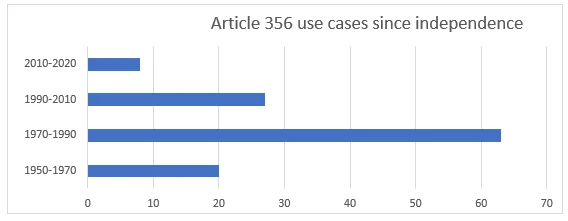Answer:
| Approach:
Introduction
Write about Article 356 of the Indian Constitution briefly
Body
- Write legal factors responsible for the reduced frequency of using Article 356 by the Union Governments since mid-1990s
- Write political factors responsible for the reduced frequency of using Article 356 by the Union Governments since mid-1990s
Conclusion
- Give appropriate conclusion in this regard
|
Introduction
Article 356 of the Indian Constitution empowers the President to suspend state government and impose direct central rule in a state if he/she is satisfied that the constitutional machinery has failed in that state. It is also called President’s Rule or State Emergency. Though it was frequently invoked initially, since the mid-1990s, there has been a noticeable decline in its usage.
Body
Legal Factors responsible for the reduced frequency of using Article 356
Judicial Pronouncements: The S.R. Bommai case (1994) stands as a cornerstone in structuring the application of Article 356. As it laid down that the power of the President to dissolve a state. Article 356 use:

- Legislative assembly is subject to judicial review.
- Doctrine of Constitutional Mandate: Over the years, the courts have emphasized the federal structure, advocating for autonomous state governance while respecting the doctrine of constitutional mandate, encouraging a more circumscribed application of Article 356.
- Guideline Establishment: Through various rulings, including the guidelines set forth in the Bommai case, the courts have delineated the proper circumstances and procedures for the invocation of Article 356, creating a legal pathway that encourages judicious use of this provision.
- Recommendations of Sarkaria Commission: The Commission recommended a restricted and judicious application of Article 356 to reinforce cooperative federalism, emphasizing the importance of maintaining a harmonious relationship between the centre and the states.
- Punchhi Commission Recommendations: This Commission further stressed the need for restraint in employing Article 356, proposing recommendations to nurture harmonious centre-state relations and promoting democratic governance.
- President’s Role: The role of the President in assessing the ground realities has become more judicial due to the scrutiny increased post the Bommai case, fostering a more considered approach before recommending the application of Article 356.
Political Factors responsible for the reduced frequency of using Article 356
- Coalition Politics: The emergence of coalition politics has nurtured collaborative governance, reduced the impulsive application of Article 356 and promoted political harmony.
- Public Perception and Media: Media scrutiny and an informed public opinion have emerged as substantial deterrents against the arbitrary usage of Article 356, holding the government accountable and fostering democratic principles.
- Regional Party Strength: The rise in the strength and influence of regional parties has cultivated a balanced power dynamic, thereby reducing the inclination of the central government to invoke Article 356 unnecessarily.
- Political Maturity: India has witnessed an evolution towards a more mature political environment, where stability and governance take precedence over power struggles, encouraging adherence to constitutional norms.
- International Image: The desire to maintain a democratic image internationally has influenced the Union governments to adhere to constitutional norms and principles, avoiding unnecessary invocation of Article 356.
Conclusion
Thus, over the years, the prudent legal interventions coupled with the evolved political climate have been instrumental in reducing the frequency of invoking Article 356, fostering a harmonious and balanced governance structure. This showcases a mature and evolving democracy that is working progressively towards fulfilling the envisioned ideals of its constitution.
